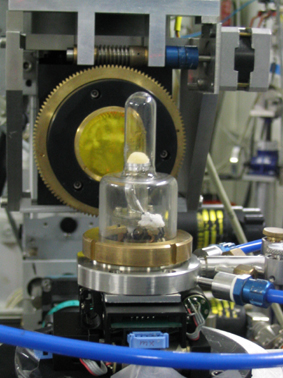- Home
- News
- General News
- The ESRF becomes...
The ESRF becomes a bakery?
18-12-2003
Share
A nice smell of freshly-baked bread pervaded on beamline BM05 at the end of November. One must have thought that oddly enough the ESRF had suddenly changed science for bakery, but the reason of the smell was simpler than that. For the first time, bread was studied by synchrotron radiation tomography while it was baked. This exceptional experiment took place on BM05 with a very recently installed microtomography set-up.
The experiment started with the in-situ investigation of fermentation of various bread doughs. The complete tomographic scan had to be performed very quickly as the dough modifies over time. With the ‘fast’ tomography technique used, consecutive scans of 400 projections over 180° were performed within 28 seconds. The exposure time of a single shot was 20 milliseconds. The dimensions of investigated samples are mainly limited by the fast shutter opening (actually being only 5 (V) by 10 (H) mm2). The second part of the experiment consisted in the in-situ observation of the bread baking in a small ‘tomographic’ oven constructed by the Sample Environment Support Service. At the end of this experiment, the dough became a piece of bread 10 mm wide and few millimetres high.
 The first bread baked in-situ at the ESRF
The first bread baked in-situ at the ESRF
The aim of the team of users, from the Institut National Polytechnique de Grenoble and the Institut National de la Recherche Agronomique (INRA-Nantes) was to see how the dough went from dense paste to a foam-like structure, and how gas bubbles appear, grow and collapse inside the matter during the fermentation and baking, until crumb setting.
The team studied plenty of bread dough with various additional components such as sugars and yeast. This study is carried out under the auspices of the French Ministry for Research and Technology and it is coordinated by the INRA. It concerns food solid foams (bread, sweet/ salted biscuits/cakes, breakfast cereals, ...) and its objectives are to find out the process, microstructure and mechanical properties relationships of these products and to provide industrialists with new tools for the quality control and better meeting consumers’ demand.
For further information, please contact Montserrat Capellas, ESRF press officer, tel. +33 476 88 26 63 (email).



